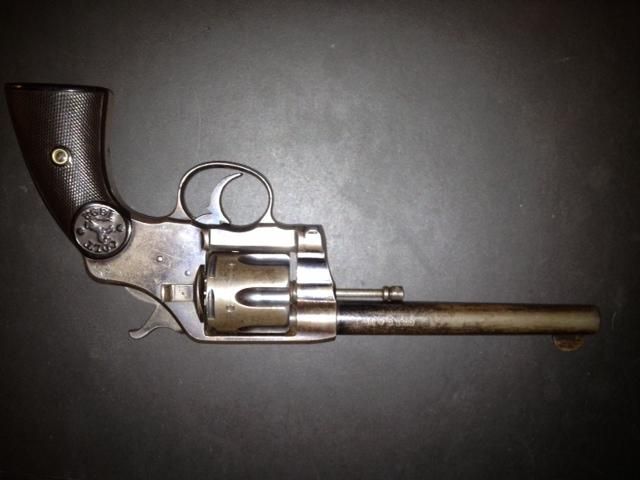I recently inherited a few guns from my grandfather. The one I am interested in is a Colt D.A. 38. I have been trying to do my research on it. I believe it is a civilian "New Navy" version made before 1905 and number 700 of that production year. I have been reading different posts and forums on different sites and that is where I have come to my conclusion. I don't really know if it's in firing order and what I have read it's hard to find parts and even harder to find a gunsmith willing to work on one. All I want to know is a little more information on the gun itself. It is marked Colt D.A. 38 on the left of barrel and has patent dates on the barrel reading "PAT. AUG.5 84, NOV 6, 88, MAR. 5 95. The serial number is 219 over 1xx. It has 700 stamped on it in 3 places that I can find with u over 700 on the inside of the frame. Grips are plastic or hard rubber with the word COLT and a prancing pony inside a circle at the top of the grips. Barrel is approximately 4 to 4.5 inches long. No visible markings on hammer or cylinder. Cylinder turns freely counter clockwise with a little bit of play clockwise while it is not cocked. When the gun is cocked it will not turn but it does have some wiggle. The gun seems to be in working condition. I would post pictures but it will not let me from my phone. Any help would be greatly appreciated.
You are using an out of date browser. It may not display this or other websites correctly.
You should upgrade or use an alternative browser.
You should upgrade or use an alternative browser.
Need help Colt D.A. 38
- Thread starter newman84
- Start date
The 700 is an assembly number; it has no relation to the date of manufacture or to the serial number. The serial number (on the butt) is 2191xx; the gun would have been made in late 1903. If there are no other markings on the butt, the gun was a civilian model, not the military model.
The cylinder should not rotate in either direction with the hammer down. Early models did, but by the time yours was made the problem had been corrected by the addition of two parts, the cylinder lock and cylinder lock spring. Your gun probably has a broken cylinder lock spring, a very common problem with those guns. It will be safe to fire and will lock up OK in firing but, as you note, the cylinder will not be locked with the hammer down.
That gun was used by the military under several different model dates. Civilian models were designated as New Army and New Navy revolvers; the only difference between the "Army" and the "Navy" was in the grip marking.
The original caliber was the .38 Long Colt; in 1904 at about 225xxx, Colt modified both military and civilian guns to handle .38 Special, but that was after yours was made.
Jim
The cylinder should not rotate in either direction with the hammer down. Early models did, but by the time yours was made the problem had been corrected by the addition of two parts, the cylinder lock and cylinder lock spring. Your gun probably has a broken cylinder lock spring, a very common problem with those guns. It will be safe to fire and will lock up OK in firing but, as you note, the cylinder will not be locked with the hammer down.
That gun was used by the military under several different model dates. Civilian models were designated as New Army and New Navy revolvers; the only difference between the "Army" and the "Navy" was in the grip marking.
The original caliber was the .38 Long Colt; in 1904 at about 225xxx, Colt modified both military and civilian guns to handle .38 Special, but that was after yours was made.
Jim
Thank you for the information on the pistol. I had been able to find some information on the gun, but I had to search several sites and make lots of notes on it. I'm sure my father will be pleased to hear what I have found out on this revolver. It seems to be a lot of research on older guns to find out much about them. My grandfather had several old double barrels that I am also going to attempt to research. Once again thanks for the knowledge Jim.
I concur on the Best book; I have a copy, bought when it first came out.
That basic gun, which began with the Model 1889 Navy, underwent a lot of changes in less than 20 years of production. Colt was feeling its way toward a viable double action revolver while trying to meet military requirements and, in later years, competition from the superb S&W Military & Police revolver.
By 1909, they had things pretty much figured out and the Army Special was the result.
Jim
That basic gun, which began with the Model 1889 Navy, underwent a lot of changes in less than 20 years of production. Colt was feeling its way toward a viable double action revolver while trying to meet military requirements and, in later years, competition from the superb S&W Military & Police revolver.
By 1909, they had things pretty much figured out and the Army Special was the result.
Jim
spacecoast
New member
I have the 1892 New Army model (made in 1894). The cylinder does not spin with the hammer down, but with the hammer fully cocked the surface of the cylinder turns about an eighth of an inch back and forth. Hence I do not believe it is safe to shoot, even if I had the right .38 Long Colt ammo (NOT .38 special).



